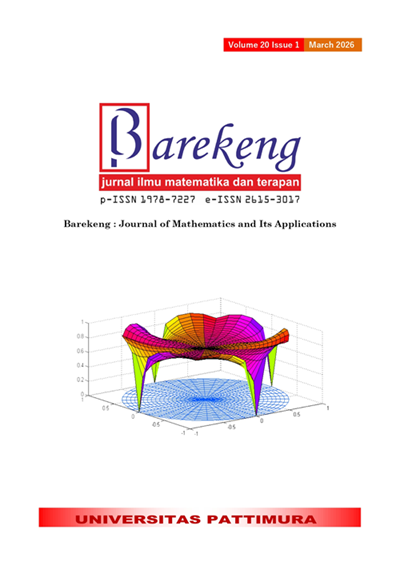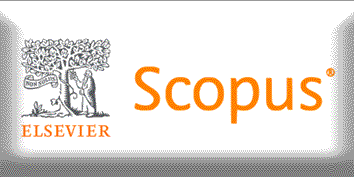ISLAMIC MORTGAGE FINANCING: DETERMINATION OF AN OPTIMAL NISBAH OF PROFIT-SHARING SCHEME UNDER MUSHARAKAH MUTANAQISAH CONTRACT
Abstract
In an Islamic investment using a profit-sharing scheme, one of the important issues to be determined is the optimal value of nisbah, so that all the parties are fairly treated. This study aims to determine the optimal constant nisbah for an Islamic home financing under musharakah mutanaqisah (MMQ) contract, to ensure a fair arrangement for both parties: the Islamic Bank (IB) and the customer. Under MMQ, the model combines partnership (Musharakah) and a leasing agreement, with gradual ownership transfer from the IB to the customers using an installment payment. For describing its dynamic, the customer’s income is assumed to follow the Geometric Brownian Motion (GMB), and the defined objective function is solved using the simulated data of payments of rental fee and ownership installment. Based on the simulation results, it will show that the middle value of a parameter of the defined objective function as a biased portion, with , is not always chosen. The objective function, which shows a parabolic plot trend, can be interpreted as a fair situation between the IB and the customer. With the selected α value, the maximum objective function value will be sought. The determined nisbah can inform policy decisions in Islamic financial institutions.
Downloads
References
OJK, “STATISTIK PERBANKAN INDONESIA VOLUME 22 NOMOR 1,” 2024.
A. W. Dusuki and N. I. Abdullah, “WHY DO MALAYSIAN CUSTOMERS PATRONISE ISLAMIC BANKS?”, Int. J. Bank Mark., vol. 25, no. 3, pp. 142–160, 2007. doi: https://doi.org/10.1108/02652320710739850
A. Kammer, M. Norat, M. Pinon, A. Prasad, C. Towe, and Z. Zeidane, “ISLAMIC FINANCE: OPPORTUNITIES, CHALLENGES, AND POLICY OPTIONS,” 2015. doi: https://doi.org/10.5089/9781498325035.006.
A. K. M. Meera and D. A. Razak, “ISLAMIC HOME FINANCING THROUGH MUSHARAKAH MUTANAQISAH AND AL-BAY’ BITHAMAN AJIL CONTRACTS: A COMPARATIVE ANALYSIS,” Rev. Islam. Econ., vol. 9, no. 2, pp. 5–30, 2005, [Online]. Available: http://irep.iium.edu.my/9713/
A. Salman and H. Nawaz, “ISLAMIC FINANCIAL SYSTEM AND CONVENTIONAL BANKING: A COMPARISON,” Arab Econ. Bus. J., vol. 13, no. 2, pp. 155–167, 2018. doi: https://doi.org/10.1016/j.aebj.2018.09.003.
Z. Hasan, “ISLAMIC BANKS: PROFIT SHARING, EQUITY, LEVERAGE LURE AND CREDIT CONTROL,” Munich Pers. RePEc Arch., no. 11737, p. 19, 2008, [Online]. Available: http://mpra.ub.uni-muenchen.de/11737/
Z. HASAN, “DETERMINATION OF PROFIT AND LOSS SHARING RATIOS IN INTEREST-FREE BUSINESS FINANCE,” J. Res. Islamic Econ, vol. 3, no. 1. pp. 13–29, 1985.
N. A. Syahri and D. A. Harjito, “THE EFFECT OF FINANCING USING THE PRINCIPLE OF PROFIT-LOSS SHARING ON PROFITABILITY LEVEL OF COMMERCIAL ISLAMIC BANK REGISTERED IN BANK INDONESIA,” Asian J. Islam. Manag., vol. 2, no. 1, pp. 46–58, 2020. doi: https://doi.org/10.20885/ajim.vol2.iss1.art5.
P. S. Chow, Y. Wang, T. M. Choi, and B. Shen, “AN EXPERIMENTAL STUDY ON THE EFFECTS OF MINIMUM PROFIT SHARE ON SUPPLY CHAINS WITH MARKDOWN CONTRACT: RISK AND PROFIT ANALYSIS,” Omega (United Kingdom), vol. 57, pp. 85–97, 2015. doi: https://doi.org/10.1016/j.omega.2013.11.007.
M. Rohansyah, Y. Yanti, A. W. Mongkito, A. Toar, and N. A. Bin Abdul Rahman, “THE EFFECT OF INTEREST RATES AND PROFIT SHARING RATIOS ON THE COLLECTION OF THIRD PARTY FUNDS,” Al-Kharaj J. Islam. Econ. Bus., vol. 5, no. 4, pp. 517–529, 2023, doi: https://doi.org/10.24256/kharaj.v5i4.4689.
A. Amiludin, “PERBANDINGAN SISTEM BAGI HASIL DAN BUNGA SERTA IMPLEMENTASI PADA BIAYA,” AKSY J. Ilmu Akunt. dan Bisnis Syariah, vol. 3, no. 2, pp. 75–90, 2021. doi: https://doi.org/10.15575/aksy.v3i2.14053.
BRI Admin, “KPR BRI.” Accessed: Oct. 12, 2024. [Online]. Available: https://bri.co.id/
A. A. Putri, “RATA-RATA PENDAPATAN GAJI DI INDONESIA 2023 - GOODSTATS DATA.” Accessed: May 08, 2024. [Online]. Available: https://data.goodstats.id/statistic/rata-rata-pendapatan-gaji-di-indonesia-2023-68Yxg
S. M. Hanafi, “THE CONTRIBUTION OF PROFIT-SHARING CHARACTERISTICS TO THE PERFORMANCE OF ISLAMIC BANKS,” Shirkah J. Econ. Bus., vol. 6, no. 1, pp. 52–65, 2021. doi: https://doi.org/10.22515/shirkah.v6i1.378.
A. U. F. Ahmad, “SHARI’AH PARAMETERS OF MUSHARAKAH MUTANAQISAH IN ISLAMIC FINANCE: THE EXPERIENCE OF AUSTRALIAN INSTITUTIONS OFFERING ISLAMIC FINANCIAL SERVICES,” ISRA Int. J. Islam. Financ., vol. 3, no. 2, pp. 7–40, 2011. doi: https://doi.org/10.55188/ijif.v3i2.130.
E. Smolo and M. Kabir Hassan, “THE POTENTIALS OF MUSHĀRAKAH MUTANĀQISAH FOR ISLAMIC HOUSING FINANCE,” International Journal of Islamic and Middle Eastern Finance and Management, vol. 4, no. 3. Emerald Group Publishing Ltd., pp. 237–258, Aug. 30, 2011. doi: https://doi.org/10.1108/17538391111166476.
A. Asadov, Z. Bin Muhamad Sori, S. Mohamad Ramadilli, Z. Anwer, and S. V. Shamsudheen, “MUSHARAKAH MUTANAQISAH HOME FINANCING: ISSUES IN PRACTICE,” J. Islam. Account. Bus. Res., vol. 9, no. 1, pp. 91–103, 2018. doi: https://doi.org/10.1108/JIABR-08-2015-0036.
DSN MUI, “FATWA DEWAN SYARIAH NASIONAL NO. 114/DSN-MUI/IX/2017 TENTANG AKAD SYIRKAH,” J. Chem. Inf. Model., vol. 53, no. 9, pp. 6–9, 2017.
N. Sumarti, MATEMATIKA KEUANGAN SYARIAH. Bandung: ITB Press, 2019.
N. Sumarti, V. Fitriyani, M. Damayanti, and A. D. Marendri, “A MATHEMATICAL MODEL OF PROFIT-LOSS SHARING SCHEME OF SMALL INVESTMENT FOR TRADITIONAL MARKET TRADERS USING THE SEMI-FUZZY LOGIC APPROACH,” Procedia - Soc. Behav. Sci., vol. 115, no. 2, pp. 131–137, 2017. doi: https://doi.org/10.21098/jimf.v2i2.650.
B. Admin, “PEMBIAYAAN KPR SESUAI PRINSIP SYARIAH.” Accessed: Feb. 02, 2025. [Online]. Available: https://www.bankbsi.co.id/news-update/edukasi/pembiayaan-kpr-sesuai-prinsip-syariah
A. Budiono, “PENERAPAN PRINSIP SYARIAH PADA LEMBAGA KEUANGAN SYARIAH,” Law Justice, vol. 2, no. 1, pp. 54–65, 2017. doi: https://doi.org/10.23917/laj.v2i1.4337.
R. Haneef, S. Kunhibava, and E. Smolo, “MUSHĀRAKAH MUTANĀQIṢAH AND LEGAL ISSUES: CASE STUDY OF MALAYSIA,” ISRA Int. J. Islam. Financ., vol. 3, no. 1, pp. 93–122, 2011. doi: https://doi.org/10.55188/ijif.v3i1.120.
A. M. Naim, “PURCHASE UNDERTAKING ISSUES IN MUSHĀRAKAH MUTANĀQIṢAH HOME FINANCING,” ISRA Int. J. Islam. Financ., vol. 3, no. 1, pp. 25–47, 2011. doi: https://doi.org/10.55188/ijif.v3i1.12.
S. A. Mikail and M. S. M. Rani, “SHARĪʿAH CONTRACTS UNDERPINNING MUSHĀRAKAH MUTANĀQIṢAH FINANCING: A CONCEPTUAL ANALYSIS,” ISRA Int. J. Islam. Financ., vol. 8, no. 1, pp. 35–66, 2016.
M. R. A. Aziz, S. I. Tamrin, A. Saad, M. Z. Mokhtar, and N. S. N. M. Nor, “MUSYARAKAH MUTANAQISAH: A SYSTEMATIC LITERATURE REVIEW,” Inf. Manag. Bus. Rev., vol. 15, no. 3, pp. 163–171, 2023. doi: https://doi.org/10.22610/imbr.v15i3(SI).3470
W. Juliyanti and Y. K. Wibowo, “LITERATURE REVIEW: IMPLEMENTATION OF MUSHARAKAH MUTANAQISAH PARTNERSHIP OVER THE WORLD,” Bukhori Kaji. Ekon. dan Keuang. Islam, vol. 1, no. 1, pp. 1–10, 2021. doi: https://doi.org/10.35912/bukhori.v1i1.196.
A. K. M. Meera and D. A. Razak, “HOME FINANCING THROUGH THE MUSHARAKAH MUTANAQISAH CONTRACTS: SOME PRACTICAL ISSUES,” J. King Abdulaziz Univ. Islam. Econ., no. 1, pp. 3–25, 2009. doi: https://doi.org/10.4197/Islec.22-1.1
N. Sumarti, “A MATHEMATICS MODEL FOR DETERMINATING THE VALUE OF IJARAH CONTRACT,” IOP Conf. Ser. Mater. Sci. Eng., vol. 288, no. 1, 2018, doi: https://doi.org/10.1088/1757-899X/288/1/012111.
W. Murniati, “SIMULASI VARIASI JUMLAH DAN PERIODE INVESTASI DALAM MODEL PROFIT AND LOSS SHARING DENGAN DANA TABARRU’ ”, Institut Teknologi Bandung, 2015.
Copyright (c) 2025 Wulan Nurul Kamilah, Novriana Sumarti, Kuntjoro Adji Sidarto

This work is licensed under a Creative Commons Attribution-ShareAlike 4.0 International License.
Authors who publish with this Journal agree to the following terms:
- Author retain copyright and grant the journal right of first publication with the work simultaneously licensed under a creative commons attribution license that allow others to share the work within an acknowledgement of the work’s authorship and initial publication of this journal.
- Authors are able to enter into separate, additional contractual arrangement for the non-exclusive distribution of the journal’s published version of the work (e.g. acknowledgement of its initial publication in this journal).
- Authors are permitted and encouraged to post their work online (e.g. in institutional repositories or on their websites) prior to and during the submission process, as it can lead to productive exchanges, as well as earlier and greater citation of published works.






1.gif)



